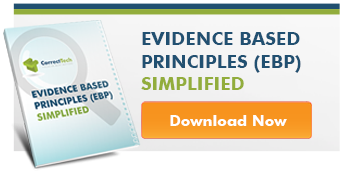Adapting CBT for Justice-Involved Clients - Check out the Blog Series!
Posted by Raymond Chip Tafrate, PhD, Damon Mitchell, PhD, & David J. Simourd, PhD on 3/13/20 6:00 AM
Topics: Assessment, Community Corrections Professional, Addiction, Relapse Prevention, client development, Developing a practice model, coaching community corrections clients, reentry, client needs and values, risk, EBP, Justice-Involved Clients, jic
What’s Behind the Box?
Posted by Raymond Chip Tafrate, PhD, Damon Mitchell, PhD, & David J. Simourd, PhD on 10/17/19 10:13 PM
Risk Assessment is Not the Same as Case Formulation
We would like to start with a story. Picture a courthouse in a struggling industrial town in Connecticut. The adult probation department is situated in the basement of this courthouse. We are beginning training with a new cohort of probation officers, teaching them how to incorporate forensic CBT techniques into their work. To start, one of the officers describes a current case and reviews the available assessment information. A quick review of the risk assessment reveals this is a high-risk case; a major area of concern is antisocial companions. We ask the officer to explain how friends and companions specifically influence criminal behavior for this justice-involved client (JIC). We get crickets! We ask, what role did friends play in the most recent offense? Again, an awkward silence permeates the room. While the officer certainly knows that antisocial companions is a risk factor for reoffending, she has not explored the nature of the JIC’s relationships and discussed with the JIC the specific role of companions in his offense history and daily routines. Unfortunately, this is a common training scenario when we begin.
Read MoreTopics: Assessment, Developing a practice model, coaching community corrections clients, client needs and values, risk, Justice-Involved Clients, jic
7 Underappreciated Hallmarks of Criminal Risk Models
Posted by Raymond Chip Tafrate, PhD, Damon Mitchell, PhD, & David J. Simourd, PhD on 9/26/19 10:00 AM
In our previous blog, we described the importance of risk reduction and the Central Eight risk domains. In this blog, we present some elements of risk models that often go unnoticed by practitioners. We believe these features of criminal risk, when applied thoughtfully, powerfully enhance supervision and case management practices. Here is how we think about risk in our work with justice-involved clients (JICs).
Read MoreTopics: Developing a practice model, client needs and values, risk, high risk client
Kickstarting Offender Coaching: Practical Strategies for Building Trust and Change
Posted by Evan C. Crist, Psy.D. on 7/6/18 11:08 PM
Key Takeaways:
- Effective coaching starts with trust—build rapport early by focusing on the client’s concerns rather than a preset agenda.
- CorrectTech supports this process by integrating evidence-based practices with real-world case management tools.
- Balancing structure with flexibility ensures each session meets clients where they are, increasing engagement and motivation.
Topics: Community Corrections Professional, Listening Skills, The Coaching Habit, Community Corrections Client Services, Developing a practice model, Evan C. Crist, Switch by the Heath Brothers, what's on your heart, coaching community corrections clients, reaching clients emotions
Developing a Practice Model
Posted by Evan C. Crist, Psy.D. on 12/28/16 3:02 PM
This blog is a continuation of the EBP Practice Models blog series started by this blog’s author Evan C. Crist, Psy.D. and other industry leading authorities on practice models, Brad Bogue, Matt Moore and Tom O’Connor.
When Brad Bogue first suggested we work on a “practice model” I was embarrassed to admit I had no idea what he was talking about. After a bit of research I realized that, while the term was foreign to me, the concept was not that complicated and was a logical extension of our agency’s evidence-based practices (EBP) training. I learned that practice models structure the use of various EBPs into a logical, coherent process to help practitioners identify the next necessary step in the intervention sequence.
Armed with lots of knowledge about EBP, but without a framework to identify and organize what techniques to use when, we recognized we did, indeed, need a practice model. Since I am writing this blog during the Christmas season, it seemed that we had lots of ornaments and tinsel but no tree on which to hang them. It became clear that without a practice model we would remain knowledgeable about EBP but unskilled in their delivery.
I looked at several of the prepackaged practice models available but found all of them lacking. They were either incongruous with my clinical experience (e.g., the importance of building motivation was essentially ignored) or contradicted my philosophy of the change process (e.g., they followed a manual but left little room for situational flexibility). With Brad at my side challenging my assumptions every step of the way, we decided to develop a practice model in house. We facilitated the process while our capable staff of case managers merged research with their experience and theory with reality.
It was a vital learning experience for me. I thought I needed to teach the case managers to think; turns out, I simply needed to create the space and let them think.
We started with the necessary requirements for the practice model:
- It must include a variety of interventions.
- It must include evidence-based, evidence-informed or promising practices.
- It must be coherent.
- It must be simple but powerful.
- It must include situational flexibility.
Topics: Policy, Practices, Change, Community Corrections Client Services, Developing a practice model, Evan C. Crist
Subscribe To Our Blog
Recent Posts
Posts by Topic
- Community Corrections (61)
- Evidence Based Practices (44)
- Community Corrections Professional (23)
- Software (15)
- Practices (12)
- Change (11)
- Technology (10)
- Risk Principle (8)
- reentry (8)
- probation staff (7)
- EBP (6)
- Outcomes (6)
- client development (6)
- client needs and values (6)
- coaching community corrections clients (6)
- Assessment (5)
- Community (5)
- Developing a practice model (5)
- Justice-Involved Clients (5)
- Remote work (5)
- The Coaching Habit (5)
- parole (5)
- risk (5)
- tele-supervision (5)
- tele-work (5)
- Community Engagement (4)
- Evan C. Crist (4)
- Community Corrections Client Services (3)
- Criminal Justice Reform (3)
- Implementation (3)
- Listening Skills (3)
- Motivational Interviewing (3)
- Policy (3)
- Positive Reinforcement (3)
- Practice Models (3)
- high risk client (3)
- reaching clients emotions (3)
- responsivity (3)
- Addiction (2)
- BOP (2)
- Conferences (2)
- ICCA (2)
- Management (2)
- Michael Bungay Stanier (2)
- Relapse Prevention (2)
- halfway house (2)
- jic (2)
- principles (2)
- procedures (2)
- program results (2)
- APPA (1)
- Appreciative Thinking (1)
- Brian Lovins (1)
- COVID-10 (1)
- Community Connection (1)
- Coronavirus (1)
- Crisis (1)
- Customer Service (1)
- Data Management (1)
- Fidelity (1)
- ICCA Seattle (1)
- Juvenile Corrections (1)
- Leadership (1)
- Monitor History (1)
- Opioid Addiction (1)
- Opioid Crisis (1)
- Orange is the New Black (1)
- Program Data (1)
- Reforms (1)
- Relapse (1)
- Second Chances (1)
- Switch by the Heath Brothers (1)
- Treatment (1)
- drug testing (1)
- going paperless (1)
- govcio outlook (1)
- impact sessions (1)
- innovation (1)
- intrinsic motivation (1)
- justice reinvestment (1)
- marijuana testing (1)
- money savings (1)
- opiod testing (1)
- paperless office (1)
- purpose (1)
- remote working (1)
- resources (1)
- sanction (1)
- staff productivity (1)
- technology solutions provider (1)
- the awe question (1)
- what works (1)
- what's on your heart (1)
- work from home (1)






